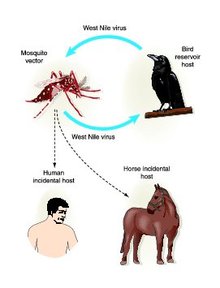Although still rare, the extremely serious disease known as Eastern equine encephalitis may be affecting more people than before.
In a recent review of two epidemics of Eastern equine encephalitis since the mid-2000s, researchers found 15 cases of the mosquito-borne illness among children in Massachusetts and New Hampshire. Normally, the U.S. Centers for Disease Control and Prevention records about five to 10 cases a year nationwide.

Increased number of equine encephalitis cases in people and horses
The name for Eastern equine encephalitis stems from the fact that the infection was first identified in horses, but the disease affects humans mostly in Atlantic and Gulf Coast states and the Great Lakes area.
"This virus is rare, but it's among the world's most dangerous viruses, and it's in your own backyard," said lead review author Dr. Asim Ahmed, an infectious disease specialist at Children's Hospital Boston.
Despite its name, Eastern equine encephalitis isn't more common around horses. The name stems from the fact that the infection was first identified in horses. The disease occurs mostly in Atlantic and Gulf Coast states, though it has recently occurred in the Great Lakes area, too. Eastern equine encephalitis can affect all age groups, according to the CDC.
In 2012 207 cases of Eastern Equine Encephalitis affecting horses were reported as of 12/11/2012.
In 2012 alone, Massachusetts had seven documented cases of Eastern equine encephalitis affecting people, which is the highest number of infections reported since 1956. What's more, the first human case ever in Vermont was reported in 2012. And, public health surveillance indicates that the virus that causes Eastern equine encephalitis may now have traveled as far north as Maine and Nova Scotia, Canada.
Results of the review are published in the February issue of the journal Emerging Infectious Diseases.
Ahmed said that better detection of the virus is at least part of the reason for the increasing numbers of people diagnosed with the disease, but he doesn't believe that better testing accounts for all the new cases.
"There's a sense that the activity of the virus has increased. People are living closer to habitats of mosquitoes in nature, and global warming is allowing mosquitoes to be active longer. Most mosquitoes thrive in warmer weather," Ahmed said.
And that's true for the mosquito that transmits Eastern equine encephalitis. Cases peak from the spring through early fall, according to the CDC.
Despite its name, Eastern equine encephalitis isn't more common around horses. The name stems from the fact that the infection was first identified in horses. The disease occurs mostly in Atlantic and Gulf Coast states, though it has recently occurred in the Great Lakes area, too. Eastern equine encephalitis can affect all age groups, according to the CDC.
People can be infected with the virus but never develop the disease. For those who develop Eastern equine encephalitis, the consequences are often severe. The death rate is about 33 percent, CDC figures show.
The disease usually begins between four and 10 days after a mosquito bite. Symptoms include a sudden-onset headache, high fever, chills and vomiting, according to the CDC. As the disease progresses, there may also be seizures and coma.
There is no specific treatment for Eastern equine encephalitis. Doctors treat symptoms as they occur.
Of the 15 children included in the study, four died, five had serious neurological problems, two had mild to moderate neurological problems and four recovered fully.
Learn more about Eastern Equine Encephalitis in Horses
